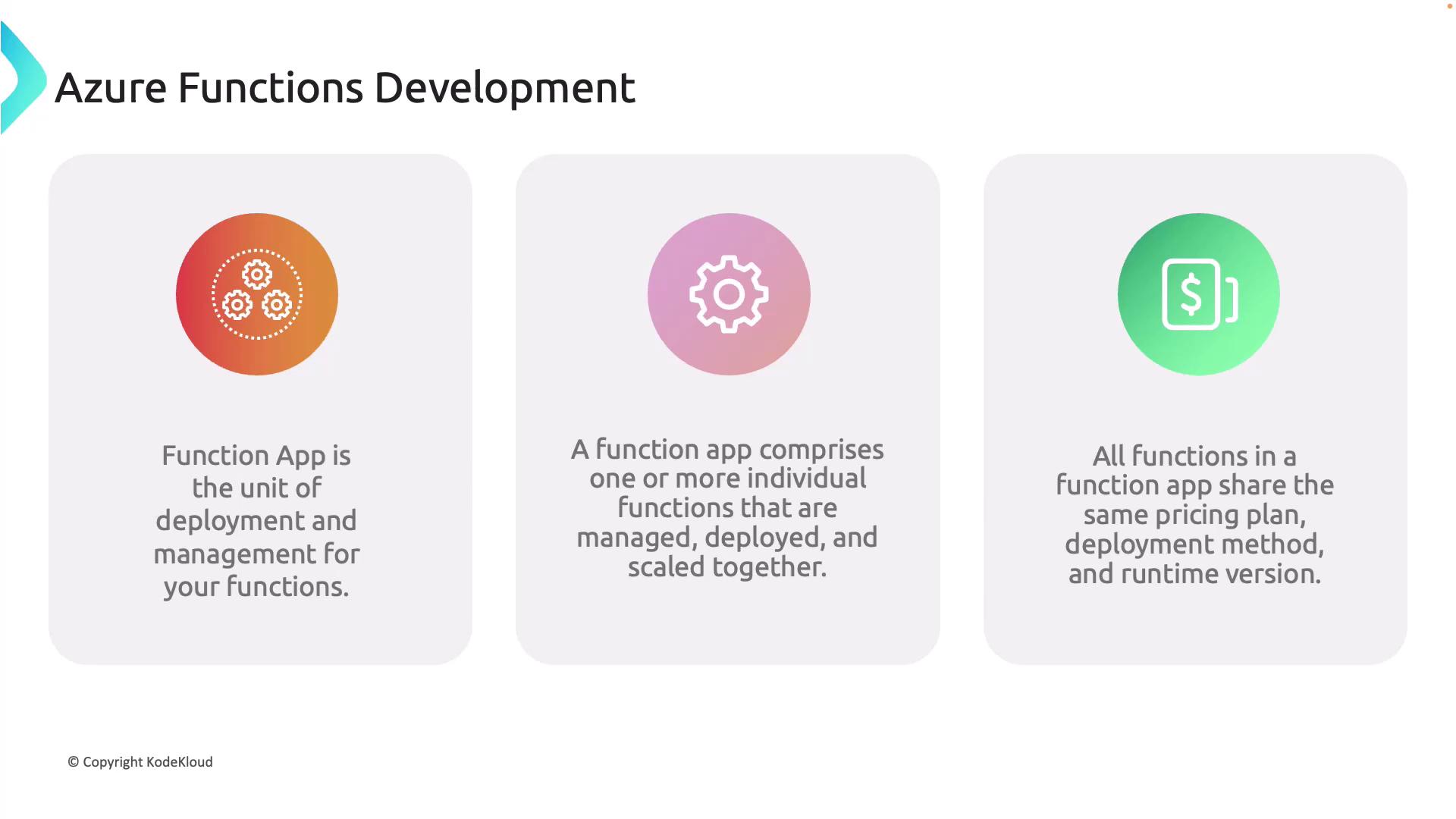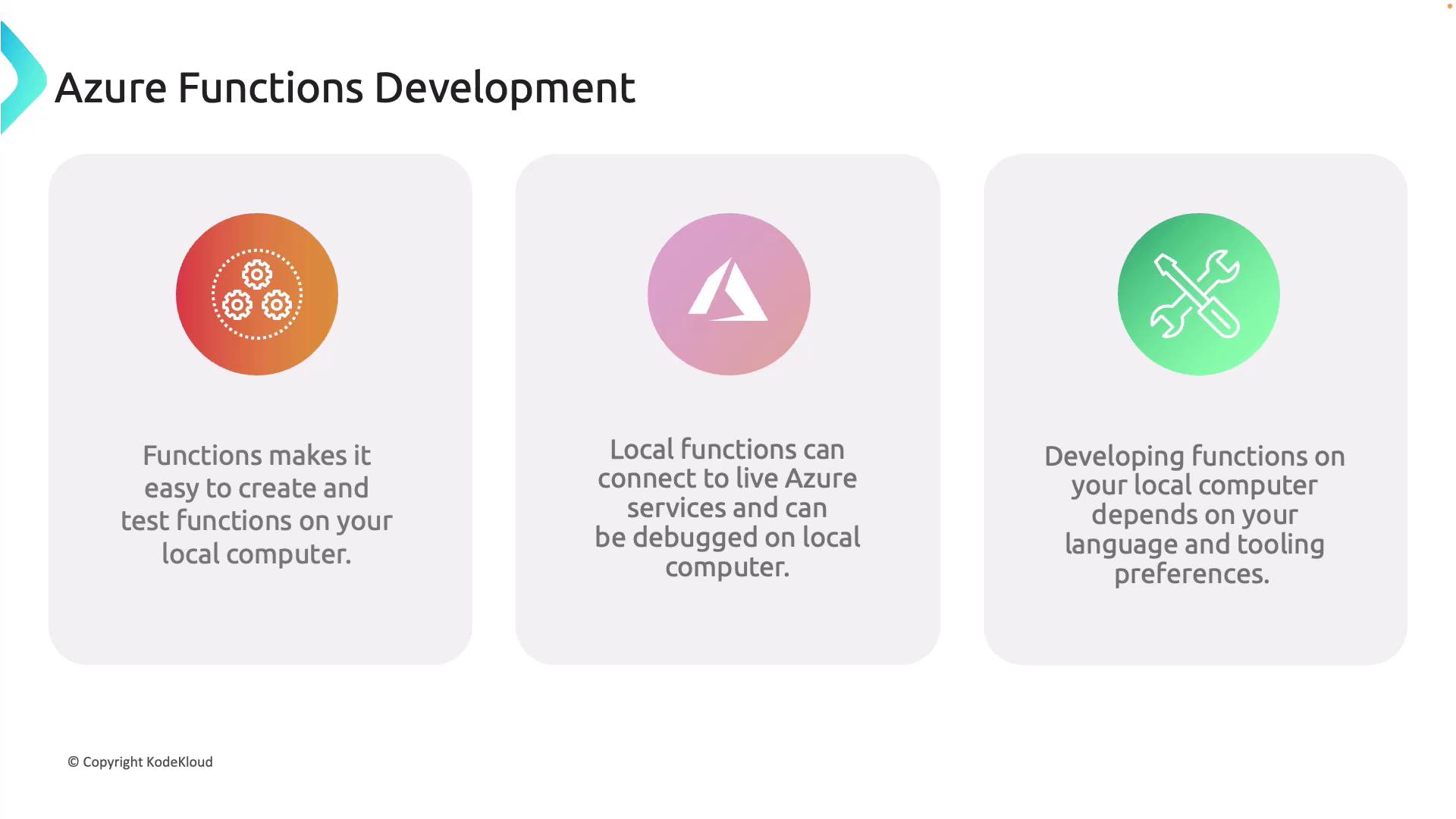AZ-204: Developing Solutions for Microsoft Azure
Developing Azure Functions
Exploring Azure Functions Development
In this article, we explore the essential aspects of Azure Functions development. We will dive into the file structure, configuration details, and best practices that streamline building and managing serverless applications on Azure.
Function App Overview
The centerpiece of Azure Functions is the function app. A function app represents the basic unit of deployment and management. Every function you create is packaged within a single function app. When deploying, managing, or scaling your application, you handle the entire function app as a unit rather than individual functions. This design simplifies administration while ensuring that all functions within the app share common settings such as the runtime version, pricing plan, and deployment method.
For example, if you have several functions for processing various parts of an order, grouping them in one app means they share the same pricing strategy and configuration settings.

If you choose a consumption plan, every function within the app adheres to consumption-based billing. Similarly, enabling continuous integration or deployment will deploy all functions together.
Local Development and Azure Integration
Azure Functions integrates seamlessly with local development tools such as Visual Studio and Visual Studio Code. This tight integration allows developers to write, test, and debug functions locally before committing to Azure deployments. Connecting to live Azure services—including storage accounts, databases, or message queues—ensures your local environment closely mirrors production, enabling faster detection and resolution of issues.
Azure Functions supports multiple programming languages including C#, JavaScript, Python, and more. The choice of development environment is flexible; whether your preference is a lightweight editor like Visual Studio Code or a full-featured IDE like Visual Studio, Azure Functions adapts to your workflow.

File Structure and Configuration
Proper configuration is crucial for optimizing Azure Functions development. Let’s review the key configuration files used within a function app.
Global Configuration: host.json
The host.json file defines global settings applicable to all functions within the app. This includes configurations for logging, retries, and extensions. For instance, if you want all functions to use a specific timeout, you would configure that setting in this file.
Below is an example host.json file:
{
"version": "2.0",
"extensions": {
"http": {
"routePrefix": "api"
}
},
"logging": {
"fileLoggingMode": "always",
"logLevel": {
"Function": "Information"
}
}
}
Key points in this configuration:
- The
"version"key indicates the runtime version (2.0). - The
"extensions"section sets a global route prefix (/api) for HTTP triggers. - The
"logging"section enables continuous file logging and sets the log level for functions to informational.
Note
For more details on global configuration settings, refer to the Azure Functions host.json reference.
Function Triggers and Bindings
Each function in Azure Functions is activated by a trigger—be it an event, a message, or a timer. Each function needs exactly one trigger, which defines when or how the function executes. Bindings complement triggers by managing how data flows in and out of the function, thereby abstracting dependencies to external resources.
Trigger Configuration Example
Below is an example configuration snippet that demonstrates how a trigger and its binding might be set up:
{
"disabled": false,
"bindings": [
{
"type": "bindingType",
"direction": "in",
"name": "myParamName"
// ... additional binding settings
}
]
}
Function-Level Configuration: function.json
Every individual function has its own function.json file that provides detailed configuration for that function's trigger and input/output bindings. Consider this example for an HTTP-triggered function:
{
"bindings": [
{
"type": "httpTrigger",
"direction": "in",
"authLevel": "function",
"methods": [ "get", "post" ]
},
{
"type": "http",
"direction": "out"
}
]
}
In this snippet:
- The first binding sets up an HTTP trigger that accepts GET and POST methods, and requires an API key (
"authLevel": "function"). - The second binding is an output binding that handles HTTP responses.
Bindings ensure that your functions interact with external services without the need to hardcode connection details.
Local Development Configuration: local.settings.json
The local.settings.json file is essential for local development, as it stores configuration values like connection strings and environment variables that mimic the cloud environment. This means you can test your functions locally with settings similar to production.
Here’s an example local.settings.json file:
{
"IsEncrypted": false,
"Values": {
"AzureWebJobsStorage": "UseDevelopmentStorage=true",
"FUNCTIONS_WORKER_RUNTIME": "dotnet",
"MyCustomSetting": "SomeValue"
},
"ConnectionStrings": {
"SQLConnectionString": "Server=(localdb)\\mssqllocaldb;Database=MyDb;Trusted_Connection=True;"
},
"Host": {
"CORS": "*",
"CORSCredentials": false
}
}
Highlights of this configuration:
"IsEncrypted": falseindicates that the file content is not encrypted.- The
"Values"section contains key settings like the Azure WebJobs Storage connection and functions runtime. - The
"ConnectionStrings"section houses connection details for databases or other resources. - The
"Host"section manages settings such as CORS configurations.
Note
Be sure to secure sensitive information and never commit production secrets to your repository. Refer to Azure security best practices for more information.
Summary
To recap, this article reviewed the essentials of Azure Functions development including:
- The function app as the primary unit of deployment.
- The benefits of integrating local development with live Azure services.
- Key configuration files such as
host.json,function.json, andlocal.settings.json, which manage triggers, bindings, and application settings.
This comprehensive overview should give you a clear understanding of the architecture and configuration essential for developing and managing serverless applications on Azure.
For further reading, consider visiting the following resources:
Happy coding!
Watch Video
Watch video content